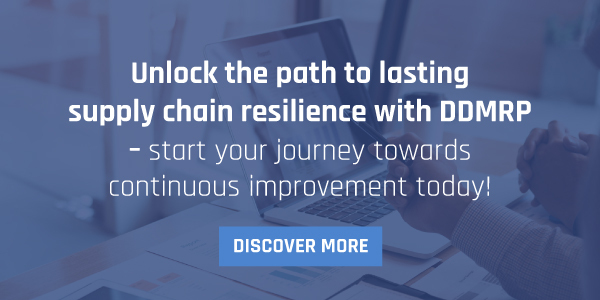
How DDMRP Turns Traditional Replenishment into a Competitive Advantage
October 4, 2024
Demand Driven Replenishment: Reducing Lead Times and Costs with DDMRP
October 25, 2024In today’s rapidly evolving business environment, where customer expectations are higher than ever and market conditions can change in an instant, supply chain agility is no longer a luxury but a necessity. The ability to respond to shifting demand, minimise lead times, and maintain optimal inventory levels without overstocking has become critical for businesses striving to stay competitive. This is where Demand Driven Material Requirements Planning (DDMRP) comes into play, offering a fresh approach to traditional supply chain planning systems. By emphasising real-time adjustments based on customer demand, DDMRP enables businesses to create more agile, responsive, and customer-centric supply chains.
This article explores how DDMRP enhances supply chain agility by enabling businesses to dynamically adjust inventory levels based on real-time customer demand. It will cover how businesses can focus on customer service by ensuring product availability without overstocking, improving responsiveness to demand fluctuations, and reducing the risk of supply chain bottlenecks.
Introduction to DDMRP and Its Relevance in Modern Supply Chains
The concept of supply chain management has evolved over the years from simple inventory management to a complex network of production, procurement, distribution, and customer service activities. Traditional planning methodologies, such as Material Requirements Planning (MRP) and Enterprise Resource Planning (ERP), have been widely used by companies to manage these supply chain activities. However, in an era characterised by unpredictable demand and shorter product life cycles, these traditional methods often fall short in responding to real-time changes. This is where DDMRP steps in.
Developed as a modern approach to supply chain management, DDMRP focuses on real-time adjustments and aligns inventory, production, and supply decisions with actual customer demand. It emphasises the need for businesses to become more agile and responsive, enabling them to thrive in the fast-paced, customer-driven market of today. But what exactly makes DDMRP so relevant? At its core, DDMRP ensures that businesses can respond quickly to demand changes, thus fostering a more agile supply chain while reducing the risks of overstocking or stockouts.
Understanding the Core Principles of DDMRP
To grasp the value of DDMRP, it’s essential to understand its core principles, which distinguish it from traditional planning approaches. DDMRP is built around six main components:
- Strategic Decoupling: The process begins with selecting strategic decoupling points, which act as buffers or firewalls within the supply chain. These points prevent the distortion of demand signals and ensure a steady supply by influencing both the generation and execution of supply orders. Deciding where to place these decoupling points is a crucial strategic choice because it affects both customer lead times and the level of inventory investment required. DDMRP uses six key criteria to determine the best locations for these decoupling points.
- Buffer Profiles and Levels: In DDMRP, buffers need to be appropriately sized to ensure that the decoupling points maintain their independence. Each decoupled item is linked to a specific buffer profile, which is a set of parameters assigned to items with similar characteristics, such as lead times, product tier, and vulnerability to supply or demand fluctuations. These buffer profiles streamline the management of many decoupled items within an organisation, helping ensure efficient inventory control across the supply chain.
- Dynamic Buffer Adjustments: In a world defined by volatility, uncertainty, complexity, and ambiguity (VUCA), flexibility is essential. DDMRP’s third component involves adjusting buffers at decoupling points in response to changes over time. Factors such as shifts in demand, variations in lead times, or upcoming events like promotions or seasonal trends are considered in these adjustments. Many of these buffer adjustments are automated in systems designed to support DDMRP, allowing businesses to remain agile in dynamic environments.
- Demand Driven Planning: The fourth component of DDMRP focuses on operational execution by applying specific rules for generating supply orders. These rules, collectively known as the “net flow equation,” are applied daily to all decoupled (buffered) positions. The demand generated at each decoupling point cascades down through the supply chain in a process called “decoupled explosion,” ensuring that supply orders are driven by actual demand.
- Visible and Collaborative Execution: In DDMRP, there is a clear distinction between planning and execution. Once a supply order is approved and converted into a scheduled receipt, the planning phase ends. The execution phase begins by managing these open orders through two types of alerts: Buffer Status Alerts and Synchronisation Alerts. These alerts help identify disruptions or issues that could impact customer commitments or compromise the integrity of the buffers, ensuring smooth operations.
- Tactical Adaptation: The final component of DDMRP deals with continuous adaptation based on past performance and future plans. Known as Demand Driven Sales and Operations Planning (DDS&OP), this process involves adjusting the DDMRP model, particularly the “Master Settings,” to reflect evolving business needs. Unlike traditional methods that rely on a master production schedule (MPS), DDS&OP introduces a more dynamic approach to managing production and supply planning, ensuring the DDMRP system remains effective over time.

Boosting Agility Through Demand Driven Planning
Agility refers to a company’s ability to swiftly respond to shifts in customer demand, supply chain interruptions, or market changes. Traditional planning systems, which often rely on long lead times and forecast-based production schedules, struggle to keep up with these rapid changes. However, DDMRP’s demand driven approach gives businesses the flexibility they need to remain agile.
DDMRP enhances supply chain agility primarily through real-time planning. By synchronising inventory replenishment and production with actual demand, companies can sidestep common issues like overstocking or running out of stock. The buffer system in DDMRP serves as a safeguard that absorbs variability, ensuring that operations continue smoothly, even when faced with unexpected spikes in demand or supply chain disruptions.
The use of decoupling points further strengthens agility by preventing disruptions in one area from impacting the entire supply chain. These strategic points allow different sections of the supply chain to function independently when needed. For example, a delay in raw materials doesn’t have to halt production because the business can rely on the decoupled inventory buffers to keep things running while the issue is resolved.
Improving Customer-Centricity with DDMRP
Customer expectations have never been higher. In today’s competitive marketplace, businesses must ensure they can deliver products quickly and reliably, while also being responsive to changes in customer demand. DDMRP helps businesses achieve this level of customer-centricity by aligning their supply chain operations with real-time customer needs.
One of the key benefits of DDMRP is that it allows businesses to improve product availability without the need for excessive inventory. By keeping inventory levels aligned with actual demand, companies can reduce the risk of stockouts, ensuring that customers receive their products when they need them. At the same time, DDMRP prevents overproduction, which can lead to excessive inventory holding costs and potential waste.
This demand driven approach also allows businesses to be more responsive to customer demand fluctuations. For example, if a product suddenly experiences a surge in demand, the DDMRP system can quickly adjust buffer levels to ensure that production is ramped up accordingly. Conversely, if demand drops, the system reduces buffer sizes, preventing overproduction and reducing the risk of excess inventory. This flexibility makes DDMRP an ideal solution for companies that prioritise customer service and satisfaction.

Reducing Lead Times and Improving Responsiveness
Lead time reduction is a critical aspect of building a more agile and customer-centric supply chain. Long lead times can result in delayed deliveries, lost sales, and dissatisfied customers. DDMRP tackles this issue by decoupling inventory positions and strategically placing buffers throughout the supply chain. By doing so, DDMRP reduces the dependency on long lead times and allows businesses to respond more quickly to customer orders.
Optimising Inventory Levels Without Overstocking
One of the biggest challenges in supply chain management is striking the right balance between inventory levels and demand. Overstocking leads to increased holding costs, potential obsolescence, and wasted resources, while understocking results in missed sales opportunities and customer dissatisfaction. DDMRP addresses this challenge by offering a dynamic, demand driven approach to inventory management.
The buffer system used in DDMRP allows businesses to maintain optimal inventory levels without overstocking. By continuously monitoring demand, supply conditions, and lead times, DDMRP ensures that inventory levels are adjusted in real-time to meet current needs. This means businesses can maintain sufficient stock to meet customer orders without the need for excessive safety stock or overproduction.
In contrast to traditional planning systems that rely on forecast-based inventory levels, DDMRP uses actual demand data to drive decisions. This reduces the reliance on inaccurate forecasts, which are often the root cause of overstocking or understocking. Instead, businesses can rely on real-time insights to ensure they have just the right amount of inventory on hand, leading to cost savings and improved efficiency.

The Role of Technology in Supporting DDMRP Implementation
The successful implementation of DDMRP requires the support of advanced technology and digital tools. Modern supply chain management systems, equipped with real-time data analytics and cloud-based platforms, provide the necessary infrastructure for businesses to adopt and execute DDMRP strategies effectively.
Real-time data is crucial for DDMRP to function optimally. Businesses need to have visibility into customer demand, supplier lead times, and production capacity to adjust their buffers dynamically. This is where advanced analytics platforms and supply chain visibility tools come into play. These tools enable businesses to gather, analyse, and interpret data in real-time, providing the insights needed to make informed decisions and adjust buffers proactively.
Moreover, the integration of DDMRP with existing ERP systems can enhance the planning and execution process. By connecting these systems, businesses can synchronise their supply chain activities, ensuring that all departments, from procurement to production to distribution, are working in harmony.
Challenges and Considerations in Adopting DDMRP
While DDMRP offers significant benefits, it is not without its challenges. One of the main barriers to DDMRP adoption is the initial investment in education and change management. Businesses need to invest in education, change management and training programs to ensure that their teams can effectively implement and manage the DDMRP process.
The transition from traditional planning systems to DDMRP requires a cultural shift within the organisation. Employees who are accustomed to working with forecast-driven models may resist the move to a demand driven approach. To overcome this, businesses must focus on change management, providing the necessary support to help employees embrace the new methodology.
Another consideration is the need for accurate and timely data. DDMRP relies heavily on real-time data to make dynamic adjustments. If data is inaccurate or delayed, the effectiveness of the DDMRP system may be compromised. Businesses must ensure that they have the necessary data infrastructure in place to support the demand driven approach.

Future Outlook: DDMRP and the Evolving Supply Chain Landscape
As supply chain dynamics continue to evolve, the demand for more agile, customer-centric supply chains will only increase. The rise of e-commerce, the growing complexity of global supply chains, and the increasing emphasis on customer service are all factors driving businesses toward more flexible and responsive supply chain models.
DDMRP is well-positioned to meet these demands. Its focus on real-time demand, dynamic adjustments, and buffer management makes it an ideal solution for businesses looking to build a more agile and customer-focused supply chain. As more companies recognize the benefits of DDMRP, its adoption is likely to grow, especially as technology continues to advance and make implementation more accessible.
Conclusion: Achieving a More Agile and Customer-Centric Supply Chain with DDMRP
In conclusion, DDMRP offers a powerful solution for businesses seeking to build a more agile and customer-centric supply chain. By aligning inventory and production with real-time customer demand, DDMRP enables businesses to reduce lead times, improve responsiveness, and optimise inventory levels. The use of decoupling points and buffer systems ensures that businesses can respond quickly to demand fluctuations without overstocking or stockouts.
As the supply chain landscape continues to evolve, businesses must prioritize agility and customer service to remain competitive. DDMRP provides the tools and strategies needed to achieve these goals, making it an essential component of modern supply chain management. By leveraging DDMRP, businesses can build a supply chain that is not only efficient but also capable of delivering the high level of service that today’s customers demand.
Reach out to discover how DDMRP can help you create an agile, customer-centric supply chain.






